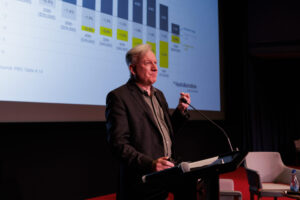While it is not polite to admit it, the plan to reduce the tax paid by wealthy Australians is one of the main reasons that Treasury predicts we will have so much trouble paying for health and aged care in the future. This is all spelt out in the IGR, albeit in the appendices.
Last week’s Intergenerational Report was full of confusing and contradictory assumptions about future policy, but its approach to the rate at which different policies are indexed tells us much about both the government’s and the Treasury’s “vision” for the future. It’s not pretty, and it’s certainly not fair.
The take-out message of the IGR is that population ageing means our tax base will dwindle at a time when public spending will be rising rapidly. Its authors argue that if we don’t cut spending now we will be swamped by ever-growing debt and deficits.
The problem is that this take-out message is unrelated to the data on which the IGR is based. The IGR actually says our annual average incomes will increase 77 per cent, from $66,400 today to $117,300 in 2054-55 in today’s dollars, and that if the government does nothing but sit on its hands, it will be flooded with revenue.
The executive summary doesn’t focus on the flood of revenue coming our way, though. Instead, it tries to scare us by insisting that our richer, longer, healthier lives are a problem to be addressed. On the other hand, the honesty about revenue projections is buried in an appendix on page 115.
The difference between my interpretation of the IGR’s numbers and the Treasurer’s is all about the rate at which income tax scales are indexed.
Like most developed countries Australia has a progressive tax system. Those who earn more money pay not just a higher amount of tax, but a higher rate of tax. Like most countries, we have thought that such an approach is fair for more than a century. Treasury’s treatment of indexation rejects it.
With a progressive tax system, total personal income tax collections grow faster than the rate of economic growth as people who are lucky enough to get big pay rises inevitably wind up in higher tax brackets. Right now, about 2 per cent of Australians earn more than $180,000 per year and, in turn, face the highest marginal tax rate of 45 per cent (plus levies). But in the next four decades, as inflation-adjusted incomes grow steadily, the number of people in the top tax bracket will steadily grow.
I know, I know, it would be ridiculous to leave the income tax thresholds unchanged for 40 years. That would cause “bracket creep” and “fiscal drag”. Both sides of politics agree this is a bad thing. The question isn’t if we should change things, but how.
Treasury’s answer is to bet that Australians are paying no attention to their assumptions about how they think tax scales should be indexed. It’s a huge bet.
The Intergenerational Report explicitly assumes that in every year between 2020 and 2055 the Parliament will pass legislation to cut tax revenue. In Treasury’s own words, “with no policy change tax collections would have risen much faster than GDP over time, resulting in a tax-to-GDP ratio considerably higher than actually occurred”.
No one is suggesting that the tax-free threshold, or the threshold at which the top tax rate kicks in, should remain unchanged for 40 years. How quickly these thresholds should rise over time is, dare I say it, a fundamental issue of intergenerational equity. Yet despite the significance of the issue, both the Treasurer and Treasury seem deeply reluctant to address it.
If the next 13 parliaments behave in the way Treasury assume then, even after adjusting for inflation, someone earning $500,000 per year will pay a lower average rate of tax than someone earning the same amount today. Why are we scratching our heads over how future generations, paying less tax than today, living in a country with a GDP three times larger than today, will fund their health and aged care?
According to the IGR’s own sums, if Australian governments simply choose to index current income tax thresholds to the rate of inflation, we would collect an extra $150 billion in income tax revenue by 2055. That’s a lot of aged care.
We could choose to impoverish ourselves by indexing the income tax thresholds to higher average wage growth instead of the CPI, but the consequences would be quite surprising and, I suspect, not that popular.
The whole point of a progressive tax system is that people who earn more should pay more tax and there is no reason that this principle should not hold over time as well as at a point in time.
While Treasury’s assumption about the need for real annual reductions in the tax thresholds is the most pernicious, the IGR is based on a wide range of implicit and inequitable assumptions.
Treasury assumes that we will never close the loopholes in our superannuation system.
It assumes we will never manage to get multinationals to pay their fair share of tax.
It assumes that the 50 per cent tax discount in capital gains will remain in perpetuity.
What’s more, Treasury implicitly assumes that if we accidentally collect more tax than we expect from one source we will automatically cut another source of revenue to ensure that the amount of tax we collect never accounts for more than an arbitrary 23.9 per cent of GDP.
Joe Hockey thinks that the age pension and the average rate of tax paid by the wealthy should both decline steadily over time. Given he once gave a speech heaping praise on the (virtually non-existent) welfare safety net in Hong Kong, that the Treasurer’s vision of a perfect society is one where the only good welfare system is an absent welfare system should not be surprising.
But building a case for your vision is different from pretending that there is no alternative. The reason we’re able to forecast such prosperity in the first place is because previous governments invested at critical junctions to achieve that prosperity. Far from being intergenerational theft, government spending was intergenerational investment. The fact that the IGR’s scare campaign has been effective does not mean it has been honest.
Of course, the future may not turn out anything like what Treasury predicts. The current plans to double our population, roll the dice on climate change and invest less in education and research may not pay the dividends that Abbott is expecting. But of all the problems we may face in the coming decades, ensuring future millionaires pay less tax than current ones would have to be one of the smaller ones.
Richard Denniss is executive director of The Australia Institute.
Related documents
Between the Lines Newsletter
The biggest stories and the best analysis from the team at the Australia Institute, delivered to your inbox every fortnight.
You might also like
Stage 3 Better – Revenue Summit 2023
Presented to the Australia Institute’s Revenue Summit 2023, Greg Jericho’s address, “Stage 3 Better” outlines an exciting opportunity for the government to gain electoral ground and deliver better, fairer tax cuts for more Australians.
The Intergenerational Report shows a massive shift towards supporting wealthier individuals’ retirements
Jim Chalmers suggests the superannuation system is the intergenerational “genius” but it really means providing more support for wealthier people who do not need it.
How the Grinch Saved Christmas
For decades, the Grinch has had a terrible reputation as a Christmas-hating monster who railed against the festivities of the season and stole the townspeople’s presents, food and decorations in an attempt to stamp out the whole technicolour carnival.


